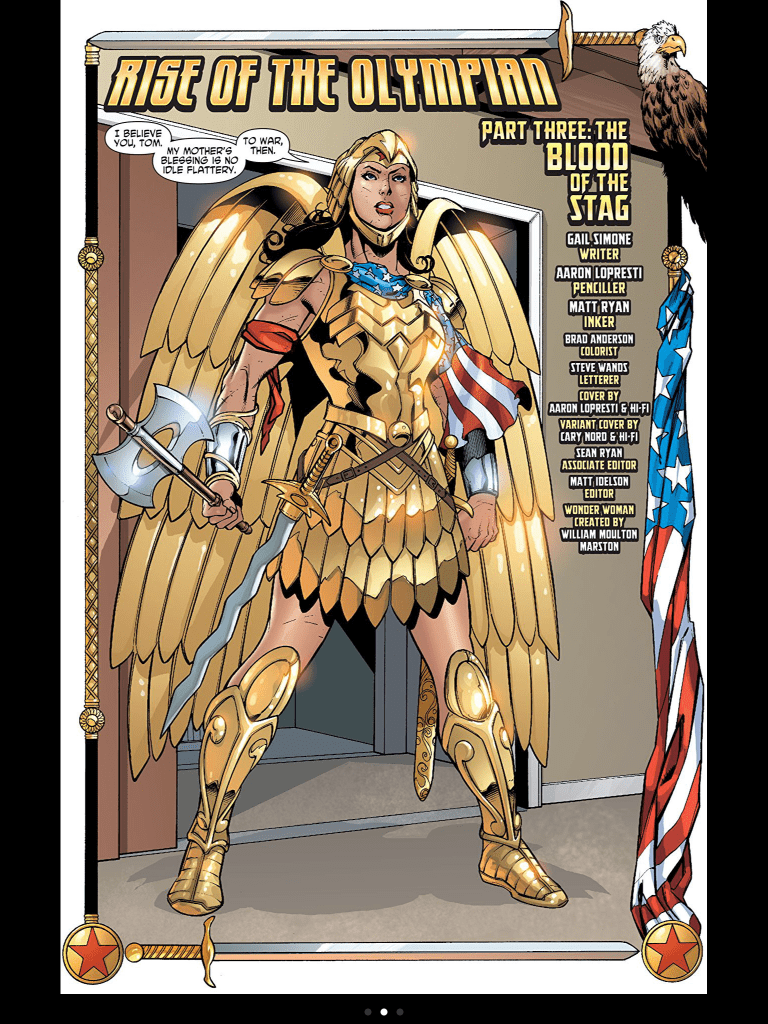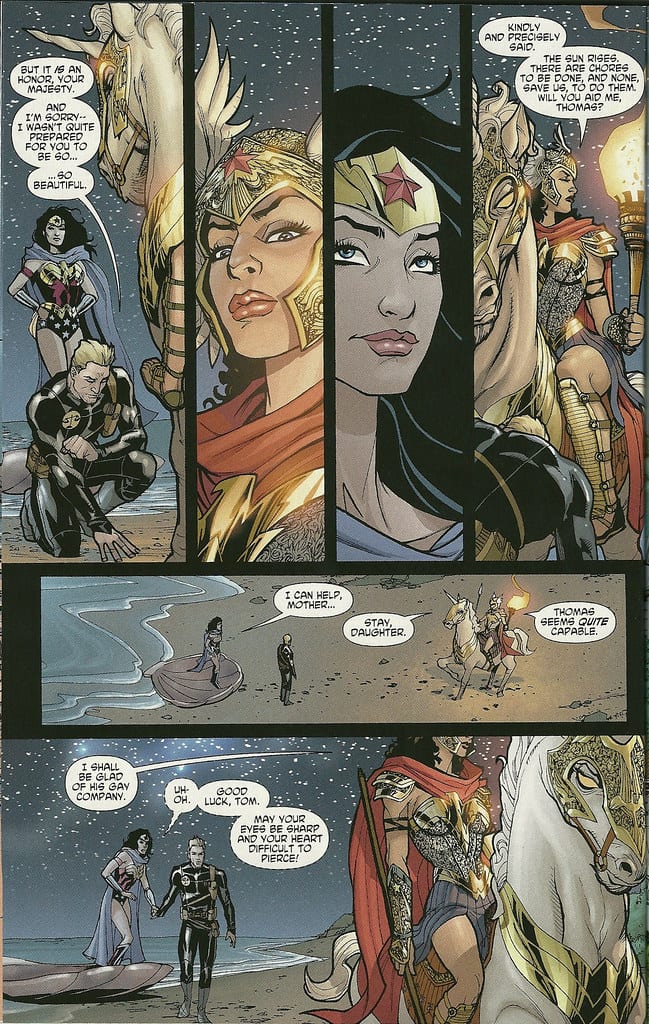Although she’s a cultural icon and a member of DC’s legendary “Trinity” of superheroes, Wonder Woman has often been mishandled by writers. As such, she doesn’t have the long list of great stories that her contemporaries have. There are only a small handful of runs that encapsulate who Diana, Princess of Themyscira, truly is as a character. Writer Gail Simone happens to be the author of one of these runs. Her 30-issue stint showcases Diana’s renewed desire to understand human culture, as well as the Amazon’s unbridled warrior spirit in ways no other writer has done. Simone also intimately captures some of the deepest, most human flaws in the character. These elements and more push Simone’s run to be one of the best and most easily recommendable runs in Wonder Woman’s publishing history.
Taking place shortly after the events of Infinite Crisis, Diana of Themyscira works as a field agent for the Department of Metahuman Affairs. Her efforts to understand human culture as an agent on their side has her crossing paths with members of the Society – and allying with some residents of Gorilla City. In her time as Wonder Woman however, she faces threats born alongside her at birth, and some that strike at her very soul. Her trials take her to the edges of existence and back home to Themyscira, to fight warriors, beasts, and gods all alike. The obstacles she faces in these issues aren’t always ones that can be beaten into submission. She will have to face her own flaws and internal demons to gain the strength she needs to continue as Princess of Themyscira and hero to humanity.
Gail Simone‘s understanding of Wonder Woman allows her to craft scenarios and conflicts that both bring out the Amazon’s absolute best, and then bring her to her lowest. The lead story arcs in this run are tense and gut-wrenching chapters that dive into the mythology of Wonder Woman’s existence and pinpoint her greatest weaknesses. The initial arc introduces key players to Diana’s coming trials, such as Tohlifar and his loyal gorillas, longtime friend Etta Candy, and chosen lover Tom Tresser. While some characters are utilized to demonstrate the loyalty and influence Diana has on others (which is a common plot point in any WW run), Tom shows the Amazon Princess in a completely new light. While the beginnings of their relationship are sweet to watch, with Diana guiding Tom through Amazon courting traditions, this later exposes the immensely flawed thinking she has about human love. This is one of the more surprising revelations in the series, as well as in Wonder Woman stories in general. It’s a painful twist that on its own already makes Simone’s run a memorable chapter of Wonder Woman’s history that’s also a sharp take on Amazon perspective as a whole.
Diana’s warped views on romance aren’t the only dagger Simone throws in Wonder Woman. She takes a close examination of Amazon society in contrast to our own, and creates a sort of “puritanical” form of living for some of the women. Simone weaves a narrative around the Amazon’s ideas and desires of motherhood, a secret desire that a select few consider blasphemous to their way of life. This mentality goes far enough to convince the Amazon warriors assigned as Hippolyta’s (Diana’s mother) personal guard to plot to kill Diana in her crib when she was an infant. Simone’s plot constantly finds ways to poke and prod at the beliefs and practices of Amazons and the gods they worship, using Wonder Woman as a vehicle for these revelations.
Gail Simone’s use of character is used to largely showcase how multi-faceted Wonder Woman’s existence is. This doesn’t mean these characters don’t have any significance on their own, however. Seeing Etta Candy taken from a bumbling Air Force egghead to a complete badass is a treat for any longtime WW fans. The inclusion of the gods creates a new dimension of characterization that isn’t much thought about in terms of how to write such beings. The internal conflict of Tom Tresser the agent vs. Tresser the man who loves Wonder Woman is believable and relatably written. Of course, the real treat in terms of character writing here is Wonder Woman and the Amazons themselves, as well as other noble warrior types who make an appearance. Diana’s compassionate sincerity is intertwined with her code as a warrior. This can be hard for writers to be able to sell and keep the story from becoming either too melodramatic or too dull. Simone thankfully manages to nail this specific tone. Wonder Woman’s voice here basks in a classical noble bravado that feels equal parts Arthurian and Robert E. Howard on Conan. Her desire for peace and love to conquer never comes off as cheesy, instead constantly surprising with how effective this tone can be when the right writer handles it. Hers and her sisters’ battlefield banter is gruff and direct in a way that had never been seen in a Wonder Woman comic before. Simone uses this as a stark reminder that these women are defenders to the ideals of peace and wisdom, but they are still masters and veterans of warfare.
Despite how riveting Simone’s main plot on Wonder Woman is, not all of the arcs fire on all cylinders. There’s one involving an attempt to make Diana’s life into a movie, and while it has some sweet and fun moments it unfortunately falls flat compared to the great work going on around it. One of the later arcs as well, and one that’s supposed to serve as a climactic follow-up to a long-running subplot, doesn’t quite add up to greatness in the end. Dialogue from many of the guest heroes that appear doesn’t hit the heights that Simone is reaching in most of her work here. The solid naturalistic speech the regulars get falls away to dialogue that can sound like it’s trying a bit too hard to have personality. While these factors do detract some from the overall experience, they aren’t enough to shake Simone’s place as one of the top Wonder Woman writers.
None of this praise for Simone’s Wonder Woman would mean anything, or would even be possible if the comic had poor artwork. Suffice to say, the visuals hold strong with the writer’s vision. Most of the work is split between artists Bernard Chang and Aaron Lopresti, with Matt Ryan as inker throughout. Each artist has his own completely distinct style, with Chang’s thick lines working in contrast to Aaron’s softer details. The whole experience is held together by Matt Ryan’s inks, which manage to leverage some uniformity to the run’s visuals. This, and the likes of Brad Anderson and HI-FI coloring to bring the experience to vivid life from panel to panel. This is a fantastic run to look at from issue to issue, with character designs and action setpieces all looking their big-budget superhero best with every turn of the page.
Gail Simone’s work on Wonder Woman stands tall as one of the pillar runs on the iconic character. Her decision to base her plot around analyzing the potential stresses in both Diana herself and the Amazon perspective results in a thought-provoking and intricate take on a legend. The characters and villains, from Etta Candy to Genocide, are all used to gain new perspective on the Amazon Princess that could now be considered essential knowledge for the character. The visuals brought forth by Bernard Chang, Aaron Lopresti, Matt Ryan, and others shine to make this run as much of a thrill to experience as the script depends on it to. This is one of the greatest takes on an inspiring icon, and deserves to be a part of any comic reader’s collection.


